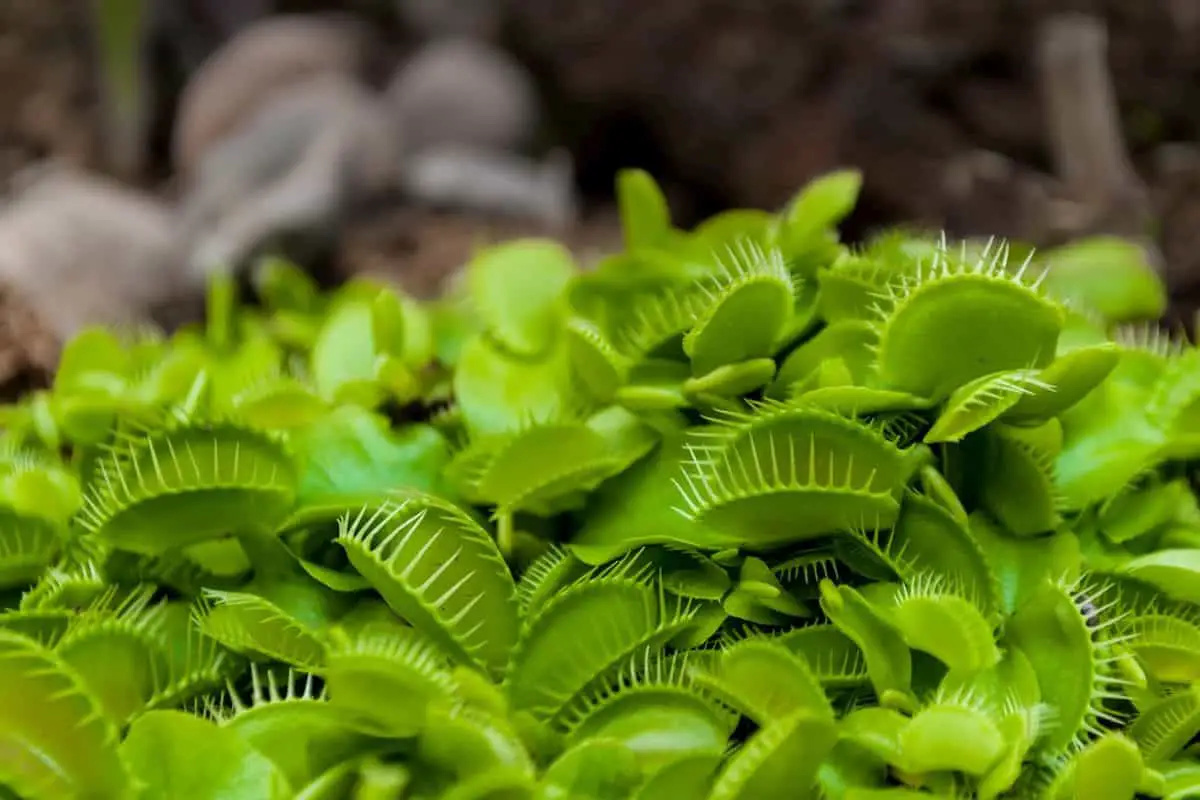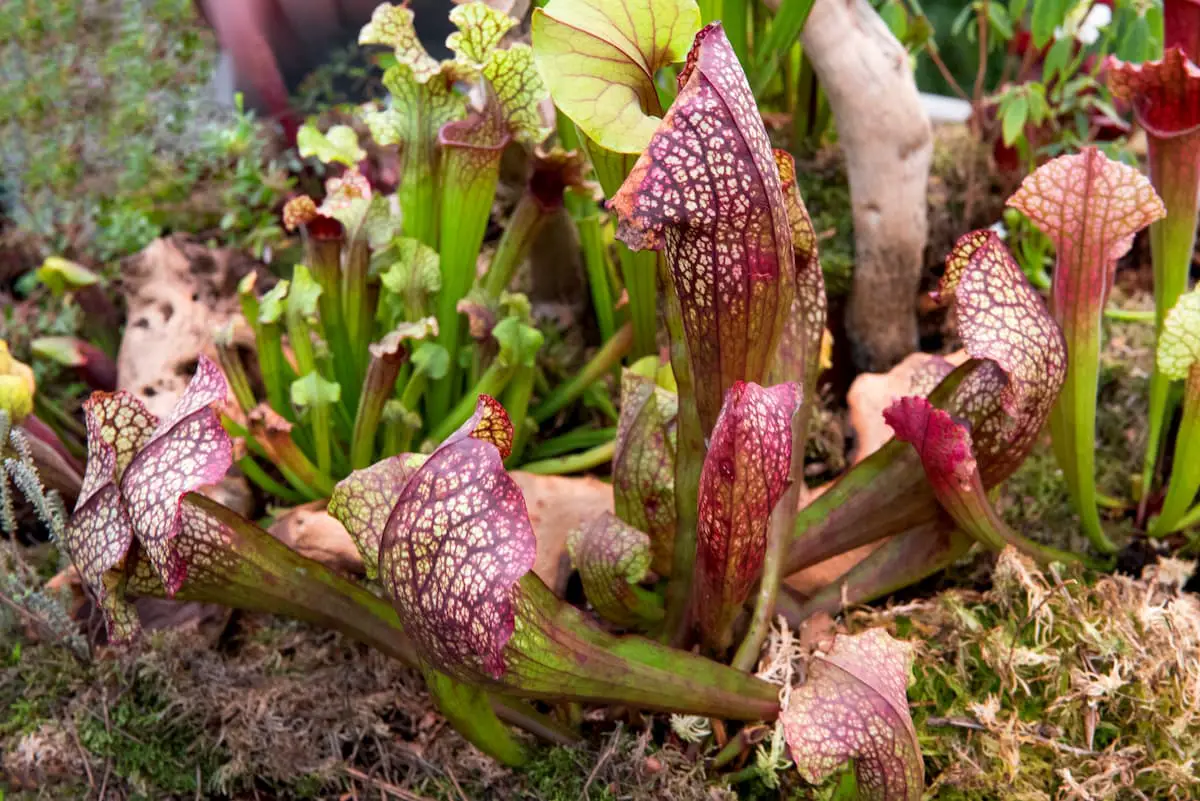Venus flytraps are known for their notorious carnivorous nature, which is rare in plants. As such, a famous naturalist and biologist, Charles Darwin, described venus fly traps as “one of the most wonderful in the world.”
They are indeed fascinating plants with unusual requirements. However, few who have seen the plant entice insects to its bifold trap might need to better understand how to care for a venus fly trap.
Venus flytraps are lethal plants with bifold jaws and spiky fringed “teeth”. They have an enticing pink center with sweet nectar that attracts their prey into the trap.
Once the insects touch the trigger hair or “teeth” twice or two hairs quickly, the electric charges close around the prey. The interlocking spiky fringes create a trap that seals due to the insect’s continuous struggle.
Subsequently, the digestive enzymes dissolve the insect’s soft tissues, and the traps absorb the nutritional fluid.
Only after a week, did the trap open to using the remains to attract new prey.
Where Do Venus Fly Traps Grow?
Venus flytraps or Dionaea Muscipula is a single species that has a minimal, very native growth range. Venus flytraps are perennial native to boggy coastal North and South Carolina areas.
However, habitat destruction in these regions has endangered its survival. Today, it is believed to have gone extinct in several of its native countries.
In their native regions, they grow in sandy soil rich in moisture and acidity but nutrient deficient.
Hence, the evolution into insect-eating carnivorous plants.
- Carnivorous Plant Soil [ Amazon ] [ Etsy ]
- Course Sand [ Amazon ] [ Etsy ]
- Sphagnum Moss [ Amazon ] [ Etsy ]
The venus fly trap soil should have all these qualities for proper growth. They require full sunlight and, like other plants, draw food from the soil and photosynthesis.
However, they fulfill the nutrient demands that the soil lacks through insects.
Venus Flytrap Cultivars
Although there is only one species of venus fly trap, Dionaea Muscipula, there are a variety of mystifying and wonderful cultivars available.
Most of these cultivars consist of a small rosette of leaves called petioles, each of which ends in a trap. The adult traps usually have around a 1-inch diameter but may reach up to 2 inches in the giant varieties.
There are different groups of cultivars, usually selected for color, size, and mutation. The first and the most popular are the all-green and all-red forms.
This group includes Dionaea ‘Justina Davis’, which remains completely green even during the full sun.
There is another group Dionaea ‘Akai Ryu‘, popularly known as Red Dragon, that develops a striking red or burgundy color over the entire plant.
Growing a Venus Flytrap
Poor, acidic soil that has good drainage but stays damp is best suited to grow Venus flytraps. Hence, one should avoid planting them in regular potting soil.
A blend of one-third sand and two-thirds sphagnum peat moss is ideal for the best drainage and is perfect for moisture retention. You should never add any fertilizer or lime to the soil.
This is an ideal condition for potting a venus flytrap at home. They grow best in bright lights; if the trap of the plant does not show a pink interior or the leaves look long and spindly, the plant probably needs more light.
Caring for Venus Flytrap
The Venus fly trap’s reputation as a complex plant to grow and care for is somewhat unwarranted.
The ability to thrive in unforgiving soil and fulfill their nutritional demand by catching their prey makes venus fly traps one of the easiest plants to care for.
Hence, if someone asks how to care for your Venus flytrap? You say easy!
Growing Locations for the Plant
Venus flytraps need healthy, direct sunlight to thrive. Hence, if you’re growing the plant indoors, ensure that you choose a bright, sunny spot to place the plant.
A sun-facing window sill or a place with abundant sunlight works for an ideal location. Sunlight deficiency can make your venus flytrap’s leaves weak and floppy, and the trap’s interior can lose its red coloration.
Although flytraps do not require a terrarium to grow, they prefer an enclosed environment with higher humidity.
Often, they are content in terrariums, provided that you maintain their winter dormancy requirements and allow sufficient sunlight.
Artificial lighting, exceptionally high-powered fluorescent lights like T5 grow lights, work well for these plants to provide abundant light indoors.
Conservatories and unheated greenhouses make the venus fly trap plant grow exceptionally well.
The temperatures in the Carolinas are often 30 degrees Celsius during summers and go below 0 degrees Celsius during winters.
Hence, if protected from the elements, these plants are pleased in humid climates or regions with similar climatic conditions.
It is important to note that venus fly traps produce different kinds of leaves throughout the growing season.
The leaves that grow during the beginning and end of the growing season are heart-shaped petioles that are lower-growing.
Leaves growing during the summers are usually elongated, and narrow petioles are held higher from the ground.
Where to Grow?
Venus flytraps grow excellently in a container or a pot kept outside. Also, it makes a beautiful addition to a sun deck or a patio. You may also grow them in a pond or a fountain if you want.
However, make sure the crown is above the water. Also, because of its specific soil requirement, avoid planting them in the ground directly.
Winter Dormancy
It is essential to mimic the conditions of the venus fly traps’ natural habitat during winter.
Venus flytraps need a cold winter dormancy between November to February, meaning you need to provide a cold resting period.
For the Venus fly traps to grow into healthy plants, they need to go dormant during winters.
Ensure that if you’re growing your plants on a windowsill or a terrarium in the growing season, you shift them somewhere colder.
For example, a garage or a shed can be an excellent place to keep them dormant.
However, if you’re growing them in an unheated greenhouse, you can keep them there throughout the winter season.
As the days shorten and the temperature drops, you will observe the leaves of the plants turning black and the plant slowly dying to the rhizome. This is normal, and there is no reason to panic.
Besides, you can always cut off and trim any dead growth. The end of winter dormancy is considered an excellent time to repot the plant.
You may even divide the plant before the growth starts in March. Usually, a 4 inch (10 cm) pot is sufficient for an adult plant to grow.
How to Care for Venus Flytraps during Winter Dormancy?
Venus flytraps conserve energy during winter for the growing season. So even though it looks like they may be dying, they are not.
You still need to provide them with adequate sunlight and water to perform photosynthesis.
- Take measures to keep the plant cool but do not let them freeze. The plant’s ideal temperature during winter dormancy is between 32 degrees Fahrenheit and 55 degrees Fahrenheit. However, it will remain dormant even at higher temperatures.
- Some people prefer to keep their flytraps in a plastic bag in the fridge. If you plan to do this, make sure you remove dead leaves and mist them with a fungicide to protect them from mold and fungal growth.
- The ideal place to keep the flytrap is outdoors. However, if your region is prone to freezing and frosting, you can keep them indoors or move them to the ground, where the soil volume protects the rhizomes. You may move them to the ground if you have created a specific bog garden.
Water Care for Venus Flytraps
Carnivorous plants require pure, unadulterated water, and Venus flytraps are no exception. They have evolved to grow in damp, low-nutrient soil.
Hence, watering them with bottled, filtered, or tap water will eventually kill your plant. Fertilizers are also avoided for the same reason.
You can get rainwater, distilled water, deionized water, or water derived from reverse osmosis.
During the growing season, one should avoid watering them from above and ensure that the pot has at least one cm filled with water. Venus flytraps grow best in damp soil that is not completely waterlogged.
During winter dormancy, they do not require much water, and the soil should be kept moderately damp.
Soil for Venus Flytraps
As stated, the age-old compost mixture for Venus flytraps is sphagnum peat moss combined with lime-free horticultural sand or perlite.
The ratio should be about 2:1.
You can easily find bags of peat-based mixes from specialist nurseries or on Amazon for Venus flytrap soil.
- Carnivorous Plant Soil [ Amazon ] [ Etsy ]
- Course Sand [ Amazon ] [ Etsy ]
- Sphagnum Moss [ Amazon ] [ Etsy ]
Today, many growers are shifting towards peat-free mixes. The environmental impact of extracting peat and its contribution to global warming creates a reluctance among growers to use peat.
A good example of having a sustainable peat mixture is finely milled bark, lime-free horticultural grit, and perlite to a ratio of 2:1:1.
Feeding
Most people ask the question, how to feed a venus flytrap? The answer to the question is simple if you’re growing the plant outside.
If the venus flytrap plant is kept outside, they can catch enough food for itself.
If you’re growing the plant inside, you may need to feed them dead or live insects. However, it is advised that you do it only after taking care of all the other growing requirements.
For the venus flytrap to properly digest its food, the trigger hair of the plant needs to be stimulated after the trap closes. This happens to prevent the plant from wasting energy on digesting non-edible things that accidentally fall into the trap.
How to Feed Venus Flytraps?
On most days, if the plant is kept outside, they can catch their prey. However, if you’re keen on feeding your plant, there are certain important things that you should keep in mind.
- Just because they are carnivorous plants, you cannot feed the plant anything that it won’t catch naturally. Hence, human food is a big no for venus fly traps. You can feed them bugs only.
- Fertilizers or any other plant-enriching mixtures should be avoided at all costs. Venus flytraps prefer growing in low-nutrient soil.
- It takes a lot of energy to close the trap. Hence, you should not trigger them if you’re not feeding them. Also, you should not overfeed the plant. One prey per week is more than sufficient for their healthy growth.
- You should only feed the plant that is ⅓ the size of the trap. The plant needs to digest the food fully. Hence, if the prey is any larger, it may cause the trap to rot and turn black.
- The digestion begins only after the trap closes fully and the trigger hair is stimulated. Therefore, if you’re feeding the plant a dead bug, gently use a toothpick to stimulate the hair. The trap soon seals shut to complete the digestion process.
Sunlight
Venus flytraps grow well in partial shade and direct sunlight for at least 6 hours minimum. However, if you want them to thrive and grow better, consider putting them in direct sunlight for 12 hours.
The morning is the best time to put them in the sun since the rays are intense but not scorching.
You should avoid direct sunlight if it is too hot outside during summer, to protect them from burning or drying.
To protect them from direct heat, you can use a cheesecloth or other light mesh fabric over the plant or place them under the shade of taller plants.




Leave a Reply